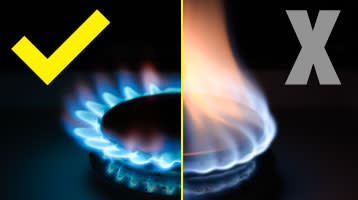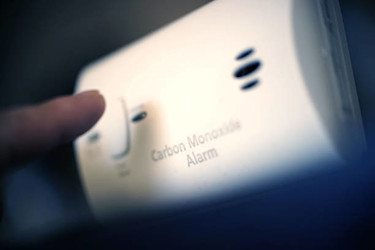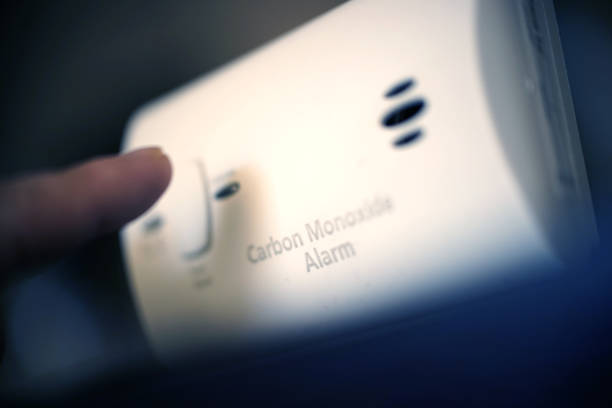What is carbon monoxide?
Carbon monoxide (CO) is a highly poisonous gas that is produced by the incomplete burning of carbon fuels such as gas or liquid petroleum gas (LPG).
Poorly fitted gas appliances or gas appliances that haven’t been maintained, serviced, or repaired properly are at risk of emitting this harmful gas.
Even small amounts of carbon monoxide can cause poisoning, and long-term exposure can result in paralysis, brain damage, or even death.
Carbon monoxide is especially dangerous because you can’t see, taste, or smell it. This is why it is vital you know how to keep your home gas safe and you know the symptoms of CO poisoning.
What are the signs of a carbon monoxide leak?
CO is released when gas appliances do not have enough oxygen to burn properly.
If you experience any of the following, it could be a sign of a CO leak in your home:
- A floppy yellow or orange flame on your gas hob or oven, rather than a crisp blue flame (see image)
- Dark, sooty staining on or around gas appliances
- Pilot lights that frequently blow out
- Increased condensation inside windows

What are the symptoms of carbon monoxide poisoning?
The six main symptoms of CO poisoning are:
- Headaches
- Nausea
- Dizziness
- Breathlessness
- Collapse
- Unconsciousness
Knowing these six main symptoms of carbon monoxide poisoning and acting fast could save a life.
CO poisoning symptoms can easily be mistaken for flu, food poisoning, fatigue, viral infections, or a hangover. If you only have these symptoms when you are at home and they disappear when you leave your property, or if others in your household (including pets) experience similar symptoms at the same time, then there is a high chance that CO poisoning is the cause.
What should I do if I suspect a carbon monoxide leak?
- Turn off gas appliances and open doors and windows
- Leave the property - get fresh air immediately
- If you think there is an immediate danger, call the Gas Emergency Helpline on 0800 111 999
- Seek urgent medical help from your GP or a hospital. They will be able to do a blood or breath test to check if you have carbon monoxide in your system and will be able to provide treatment if necessary.
If carbon monoxide is found in your bloodstream, no one should enter your property until a Health and Service Executive allows it.
If no carbon monoxide is found in your bloodstream, a Gas Safe registered engineer can visit your property to complete a safety check and repair any faults if necessary.
Let us fix your boiler.
At Smart Plan we have thousands of engineers up and down the country who are ready to fix your issue. We guarantee an engineer to your property within 48 hours.
How will I know if I have a carbon monoxide leak?
Install a carbon monoxide detector

Installing a carbon monoxide detector could help save lives in the event of a CO leak. Carbon monoxide detectors work by sounding an alarm when carbon monoxide is detected and can be installed in different locations around your home.
CO detectors can be purchased online and from most DIY stores. It is advisable to install a CO detector in every room that has a gas appliance and to test them regularly.
To be sure of a CO detector’s effectiveness, check that it is marked BS EN 50291-1:2010 (for domestic premises) or BS EN 50291-2:2010 (for caravans and boats) and make sure it displays the British Standards’ Kitemark (see image).

Please note, as CO detectors only alarm when carbon monoxide is present, you should never rely on one as a sole form of prevention.
Black spot indicator patches
Warning
We strongly recommend that you do NOT use a black spot indicator as your main alert for a CO leak.
Black spot indicators may be helpful when used in conjunction with a CO detector.
Black spot indicator patches are patches that you can place above a gas appliance to alert you if carbon monoxide is detected. They have a small light-coloured circle that changes colour if CO is detected.
The problem with black spot patches is that you will only know if carbon monoxide has been detected if you look at the patch. If there is a dangerous build-up of carbon monoxide while you are asleep or in a different room to the faulty gas appliance, you will not be alarmed to the potentially deadly issue. Due to this, Amazon and eBay have stopped selling black spot indicators.
How can I prevent a carbon monoxide leak in my home?
Professional maintenance of gas appliances
The main way to prevent a CO leak in your home is to ensure your gas appliances are correctly installed, repaired, and serviced by a Gas Safe registered engineer.
Gas Safe engineers are the only people legally permitted to work on gas appliances.
Do not cover air vents
Air vents ensure your gas appliances work safely. Natural gas and liquid petroleum gas (LPG) require a certain amount of oxygen to burn correctly. If there is not enough oxygen, the fuel (gas) will not burn completely and will produce carbon monoxide.
Click on one of the links below for further gas safety advice and information.


